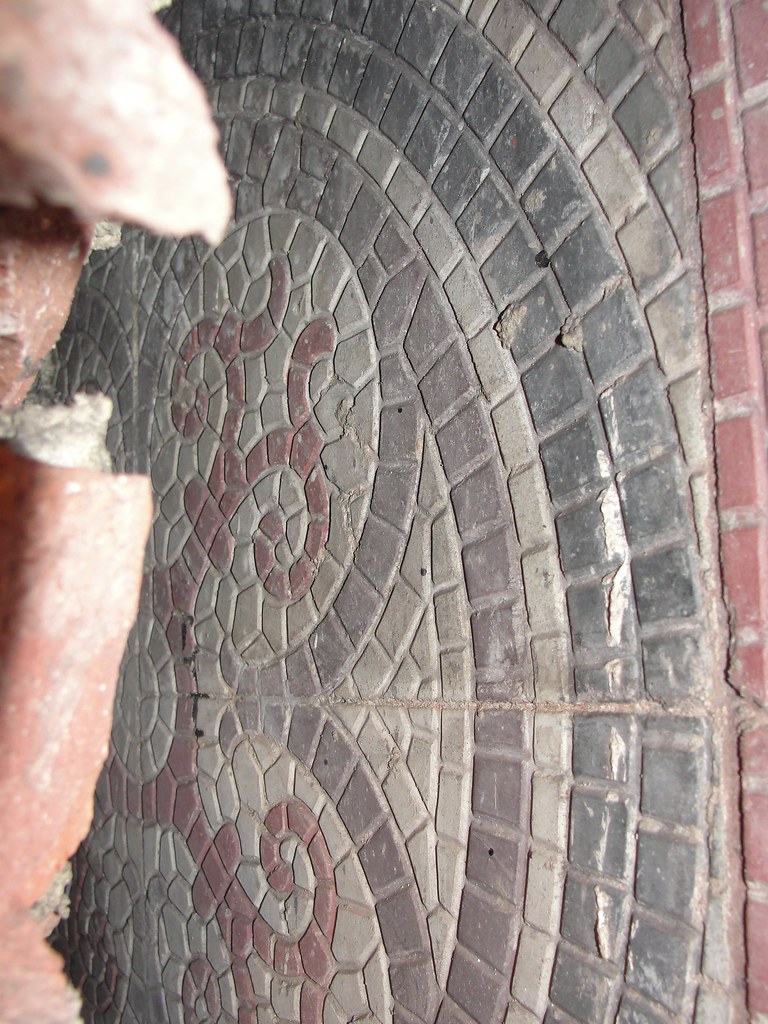
As the Columbus Circle station rehab has progressed, MTA work crews have uncovered an impressive array of subway history. Three years ago, a plaque from 1901 resurfaced after over a century behind brick and tile, and last week, another 109-year-old mosaic reared its head.
The Times first broke the story last week with an excellent headline — Behind an Old Subway Wall, a Glimpse of an Even Older One — and David Dunlap provided us with the story. Much like the circa-1901 plaque, this newly discovered old wall was part of the Heins & LaFarge testing ground for various subway station designs. He writes:
Another keyhole to the past opened recently on the uptown platform of the No. 1 train at the 59th Street-Columbus Circle station. Through a gap in the current wall, under one of the ceramic plaques of Columbus’s flagship, an unusual pattern can be discerned dimly: an interwoven guilloche pattern — sort of like a two-dimensional challah crust — in red and yellow mosaic tiles.
Viewed from a perch on the nearby bench, the wall reveals more of itself. (We spread out a newspaper on the seating area, taking advantage of the broad utility of the print medium.) Next to the guilloche border is a large blue-gray mosaic medallion, enclosing a four-lobed pattern known as a quatrefoil. It’s unclear whether it is a true mosaic, with individual tiles, or a mosaic pattern stamped on to a large surface.
What we do know is that it stretches far back into the past; to 1901, in fact, three years before the subway actually opened. In “Silver Connections” (1984), his monumental history and description of the New York subway, Philip Ashforth Coppola described the Columbus Circle station as having played a critical role in the development of the system. “It was virtually the first station to be completed in structural form,” he wrote. “Because of this, the architects used its walls as an art gallery, experimenting with decorative ideas in various colors of tiles and other materials.”
New York City Transit officials know that this wall is quite historic, and they hope to conserve and display it. “We are well aware of the historical significance of this find,” Charles Seaton said to The Times, “and we are working on a design for a window in the wall so this treasure can be shared with the public at some future date.”
Meanwhile, after 109 years of isolation, the wall, as of Friday, was on display on the northbound 1 platform for all to see. As I snapped some photos — embedded after the jump — two other New York City history buffs wandered over to espy this bit of subway history. Were we were among the first people to see something buried since the McKinley Administration? Perhaps so.
Click through for a brief slideshow of photos from the Columbus Circle station. Most of the mosaic remains hidden behind the wall, but it’s possible to see glimpses and fragments of it.

4 comments
Almost equally as impressive is that you linked to a blog post you made nearly three years ago. This speaks not only to the longevity of your work, but to the loyal following you’ve developed. Congratulations!
It’s amazing the quality and craftmanship that was used 100 years ago compared to today. The materials used to build the original subway were so superior to the garbage that they use today.
But the high quality and good craftsmanship ended up being way too expensive. That’s why the entire system doesn’t look like the Columbus Circle relics or the abandoned City Hall stop.
[…] unused lower levels — 42nd St. and 8th Ave., Bergen St. and 9th Ave. in Brooklyn — and antique walls remind us of the city’s past. The subway’s planners made mistakes. They built too many […]